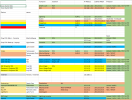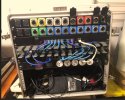zerowaitstate
Well-Known Member
Seeking advice on execution.
I am looking to isolate NDI traffic as i see that as fairly heavy and has potential to slow other control protocols, its use to push generated video to the media server.
Currently DHCP is from the modem, and pases through the to the cisco i feel this would be better if its handled by the Cisco's as if the modem craps out all is lost. if dhcp was through cisco's and the modem fails only thing lost is internet ... not the end of the world.
PC's have access to the interent, i would preffer to have them to be isolated, unless i need to allow access specificly (software updates)
im not sure if i have the concept of VLAN vs subnet masking to manage what can see each other
The colours in table and the physical set up is still to be locked down ...i have:
3 video projectors - White
2 laser projectors Yellow >> FB4's
lighting desk (arnet ) Green ?
Wing CAT 5 to console or USB usb to laptop
2 x universe from wing RED
video projectors are purely for control of source and a shutter to protect lens etc via a web or madmapper software
Beyond sits in this road case and is internally plumbed to the switch
this is a small touring rig but i am wanting it to be able to scale


Any help or advise appreciated ... happy to set up a remotes seeeion to get in to the nity gritty, also pay to pay a medest fee
I am looking to isolate NDI traffic as i see that as fairly heavy and has potential to slow other control protocols, its use to push generated video to the media server.
Currently DHCP is from the modem, and pases through the to the cisco i feel this would be better if its handled by the Cisco's as if the modem craps out all is lost. if dhcp was through cisco's and the modem fails only thing lost is internet ... not the end of the world.
PC's have access to the interent, i would preffer to have them to be isolated, unless i need to allow access specificly (software updates)
im not sure if i have the concept of VLAN vs subnet masking to manage what can see each other
The colours in table and the physical set up is still to be locked down ...i have:
3 video projectors - White
2 laser projectors Yellow >> FB4's
lighting desk (arnet ) Green ?
Wing CAT 5 to console or USB usb to laptop
2 x universe from wing RED
video projectors are purely for control of source and a shutter to protect lens etc via a web or madmapper software
Beyond sits in this road case and is internally plumbed to the switch
this is a small touring rig but i am wanting it to be able to scale


Any help or advise appreciated ... happy to set up a remotes seeeion to get in to the nity gritty, also pay to pay a medest fee

![IMG_4933[1].JPG](/data/attachments/1/1908-c497679db9f1ed9271622923c399a267.jpg?hash=KJQxNOc8ou)